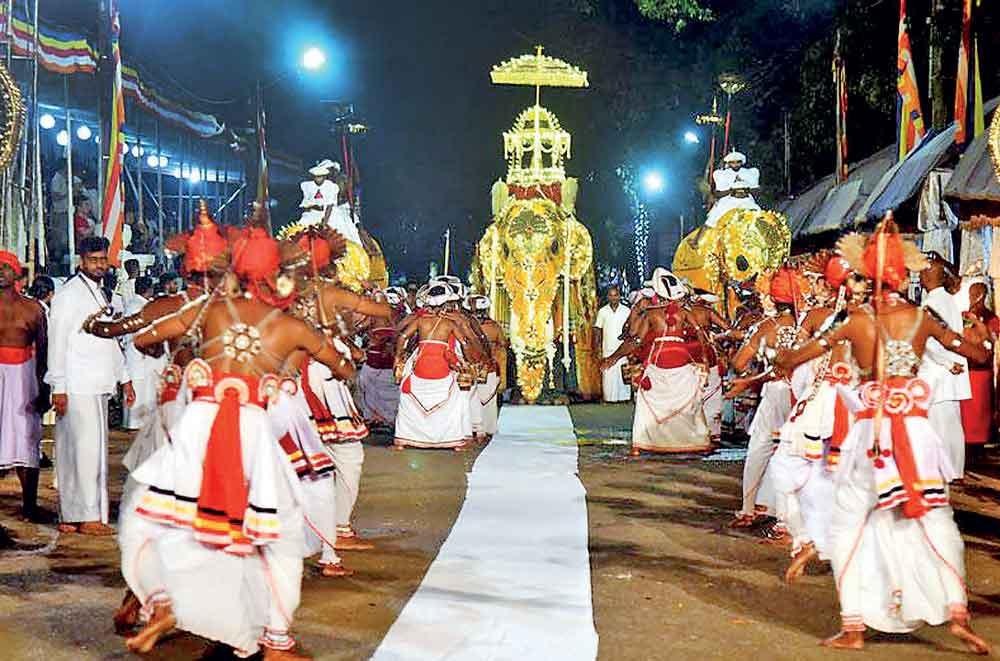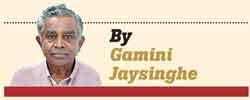THE MOST COLOURFUL LOW – COUNTRY PROCESSION OF KELANIYA RAJA MAHA VIHARAYA
| ANNUAL DURUTHU MAHA PERAHERA |


The majestic tusker walks in all his majesty and dignity, pacing the white carpet cloth. Pix by Pradeep Pathirana
 The colourful Duruthu perahera of Kelaniya Raja Maha Viharaya is held annually on the pre-full moon poya day in the month of Duruthu (January) to commemorate Buddha’s third visit to Sri Lanka. According to chronicles the Exalted One visited Kelaniya on the Vesak full moon poya day at the invitation of Naga King Maniakkhika. The invitation was made when the Blessed One visited Nagadeepa three years earlier to quell a rebellion among Nagas of Nagadeepa led by Naga kings Chulodara and Mahodara. The Naga kings offered the gem throne to the Blessed One on which He sat to preach Dhamma. Enshrining this throne, a dagaba had been built. This dagaba which is in the shape of a heap of paddy is 180 feet in circumference. Within the temple premises there are devalayas dedicated to Kataragama, Vishnu and Vibhishana deities.
The colourful Duruthu perahera of Kelaniya Raja Maha Viharaya is held annually on the pre-full moon poya day in the month of Duruthu (January) to commemorate Buddha’s third visit to Sri Lanka. According to chronicles the Exalted One visited Kelaniya on the Vesak full moon poya day at the invitation of Naga King Maniakkhika. The invitation was made when the Blessed One visited Nagadeepa three years earlier to quell a rebellion among Nagas of Nagadeepa led by Naga kings Chulodara and Mahodara. The Naga kings offered the gem throne to the Blessed One on which He sat to preach Dhamma. Enshrining this throne, a dagaba had been built. This dagaba which is in the shape of a heap of paddy is 180 feet in circumference. Within the temple premises there are devalayas dedicated to Kataragama, Vishnu and Vibhishana deities.
This is the most colourful and popular low-country pageant in Sri Lanka heralding in the New Year according to the Gregorian and Julian calendars.
Hundreds of thousands of local and foreign tourists throng the temple premises to witness this spectacular pageant.
A RITUAL DEPICTING THE AGE-OLD CUSTOMS AND CEREMONIES
The procession by itself is a ritual depicting the nation’s age-old customs and ceremonies. It demonstrates to the world, age-old traditions, folklore, folk-music and rhythmical dance forms and drum beats which have been developed throughout the ages based on Buddhism and Buddhist practices in the island.
INAUGARATION IN 1927 WITH WALTER WIJEWARDENA AS PATRON
The great pageant known as Kelani Duruthu perahera was inaugurated in 1927. Its pioneer was Don Walter Wijewardena, son of Mrs. Helena Wijewardena of Sedawatte walawwa. At its inception there were only two divisions in the perahera, – the Dhatu perahera conducted in homage of the Buddha relics and Vibhishana devalaya perahera in dedication to god Vibhishana, the patron deity of Kelaniya. Later, two other divisions were added, the Vishnu devalaya perahera in 1930 in honour of god Vishnu, the patron god of Sri Lanka and Kataragama devalaya perahera in 1954 in dedication of god Skandha Kumara. Hence today, the Kelaniya Duruthu perahera is composed of the Dhatu perahera followed by Vishnu, Kataragama and Vibhishana devala peraheras.
DURUTHU FESTIVAL CELEBRATED IN THREE STAGES
Duruthu festival is celebrated in three stages. It commences with a series of sermons (Dhamma Desana) followed by a week’s Pirith-chanting ceremony (Pirith Desana). Subsequently the famous procession, Duruthu perahera is held at night on three consequent days prior to Duruthu full moon poya day.
THE FIRST DAY PERAHERA
The first day perahera held in the upper terrace is called the Udamaluwa perahera. On this day only the Dhatu perahera is conducted and that too on a small scale. Flag bearers, whip crackers, fire ball dancers, drummers and dancers take part but in their small numbers. Basnayaka Nilame and members of the Dayaka sabha (the organising committee) participate in the procession attired in their white dress. The Chief Basnayake Nilame or his deputy carries the sacred casket placed on a colourful cushion by hand and in full reverence. In this manner, the perahera perambulates the upper precincts of the temple covering the areas of the sacred Bo tree, the Dagaba and the Viharage (image house). It completes three full circuits and returns to the temple. The sacred casket is then replaced in its chamber.
THE SECOND DAY PERAHERA
The second day perahera is more colourful than the first and is performed on a more extensive and elaborate scale. This time all the composite divisions of the procession line up in their respective order. The Dhatu perahera leads and the three devalaya peraheras trail behind and form the tail end. This time the perahera takes to the streets of the lower temple square and is therefore called the Pahatha Maluwa perahera. The elephant carrying the sacred relic casket in the Dhathu perahera and those carrying the divine insights in devala peraheras form the composures of each perahera. Basnayake Nilame and his retinue in attendance follow immediately behind. After making one circuit around the temple, the perahera returns (Gevadinawa) to the temple.
RANDOLI PERAHERA -THE THIRD AND FINAL PROCESSION
The third and the final procession called the ‘Randoli’ perahera is the climax of the whole festival. It is usually held on the pre-poya day of the Duruthu month. This is one of the most colourful and magnificent spectacles that the Buddhists of Sri Lanka look forward to with great favour and enthusiasm.
Before the commencement of the procession the divine insignia of the respective gods are ceremonially conducted out of each devalaya amidst the beat sounds of Hewisi drums and are securely placed on the howdah placed on the backs of the respective tuskers.
Then the ceremonies connected with the commencement of the grand procession are performed in the outer chamber of the Samadhi statue. The officiating monks and Basnayaka Nilames led by the Chief Basnayake Nilame assemble in front of the Samadhi statue and wait in anticipation. Then the perahera rituals begin.
At the outset, Pansil (The Five Precepts) is being administered. The venerable Viharadhipathi Thera or Chief incumbent delivers a short address on the significance of the moment. Next the sacred conch is blown thrice in consecration, inviting the blessings of gods followed by the beating of the festive drums (Magul Bera), and then amidst the chanting of Seth Pirith, the Viharadhipathi Thera hands over the sacred relic casket to the chief Basnayake Nilame. At this auspicious moment a cannon booms to announce that the perahera has commenced. The sacred relic casket is conducted out of the Viharage by the chief Basnayake Nilame with the traditional Hewisi band and the group of ves dancers performing in front. At the belfry, the sacred casket is placed in the decorated howdah, the gilded octagonal seat up on the back of the tusker and the perahera now begins to move forward down the street below.
Heading the procession come the whip crackers in single row cracking their whips at regular intervals. They indicate the approach of the perahera. They are followed by a group of fire ball performers (Gini bola karuwo). They parade the street in various formations, swinging and working hundreds of stringed fire balls, making various patterns and designs in the air. They are followed by elephants carrying the National flag symbolising the nation. Next comes a group of uniformed flag bearers. They march in two rows carrying the colourful banners and flags of different districts and provinces (Korala Kodi and Disa Kodi). A troop of Hewisi drummers comes next playing different drum beats. They are followed by an elephant carrying the Buddhist flag. Close behind, march more flag bearers in two rows on either side. The elephant that comes next carries a Naga kodiya, the flag of Kelaniya followed by a troop of flag bearers and troops of dancing drummers.
Mounted on his elephant comes the Peramune Rala, the frontiersman in his customary dress carrying in his hand chronicles or the Lekam mitiya. Riding the next elephant is the Gajanayake Nilame, the chief in charge of the elephant kraal. He carries in his right hand a silver goad which is the symbol of his office. A row of elephants in full panoply and array comes next. Troops of dancers and drummers representing various schools of dancing in the hill country, low country and Sabaragamuwa punctuate each interval. Then comes the Kariya Karawana Rala, master of ceremonies attended by his retinue, dancers and drummers.
They are followed by two Buddhist monks in their saffron robes representing the brotherhood of Sangha and their role as the curators of Buddha relics. Walking underneath the traditional yellow parasol held over them, they pace at an easy solemn pace.
MAJESTIC TUSKER CARRYING THE RELIC CASKET
Then comes the majestic tusker of noble birth carrying the sacred relic casket on his richly caparisoned back. He walks in all his majesty and dignity, pacing the white carpet cloth (pawada) spread on the floor of the road with pride. It is indeed surprising to see how he walks with solemn grace, fully aware of the sacred duty he is chosen to perform. He would not take a single step forward unless and until the white cloth is spread before him. Any delay in spreading pawada would bring him to an abrupt halt. He is flanked by two other elephants. Two white clad attendants riding on them strew fragrant jasmines on the sacred casket in reverential homage. Before the tusker moves, a troop of Kandyan ves dancers, dance to the beat of drums and sing songs of high praise.
CHIEF BASNAYAKE NILAME – LAY CUSTODIAN OF THE SACRED RELIC CASKET
Behind the tusker, under the colourful parasol held aloft comes the chief Basnayake Nilame dressed in his princely Indian costume. He is the lay custodian of the sacred relic casket. He is attended by a troop of ves dancers in front and his personal entourage of vidanes and attendants in the rear, clad in their customary Kandyan costumes. These attendants carry their traditional spears (muraayudha), umbrellas (sesath) and talipot leaves.
The official dress of the chief Basnayake Nilame of Kelaniya is different from that of Diyawadana Nilame of Kandy Sri Dalada Maligawa.
The Dhatu perahera, the main division of the Randoli perahera ends at this point. The three Devale perahera then follow in their respective order.






